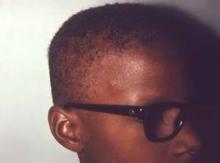Scarring alopecia is a common and devastating disease in skin of color patients. Although many controversial studies have looked at the effects of styling techniques and chemical treatments on hair loss, no direct relationships have been found.
A recent study published in the Journal of Cosmetic Dermatology found that there was an increased baseline level of the profibrotic cytokine IL-1 alpha and the IL-1 receptor antagonist in the scalp sebum of afro-textured hair. The study also highlighted the increased susceptibility to scarring alopecia in black patients.
Interestingly, the levels of the profibrotic cytokines increased with chemical treatments and decreased with shampooing, which is also a feature unique to black patients.
When evaluating patients with scarring alopecia, I often inquire about shampooing frequency and chemical treatments. The frequency, type of treatment, chemical used, color used, and relaxing techniques are factors I document in order to evaluate hair loss for every patient.
This study sheds light on the increased risk of scarring alopecia in black patients; and it should alert dermatologists to elucidate hair practices in all patients with hair loss.
- Lily Talakoub, M.D.
Do you have questions about treating patients with darker skin? If so, send them to sknews@elsevier.com.


